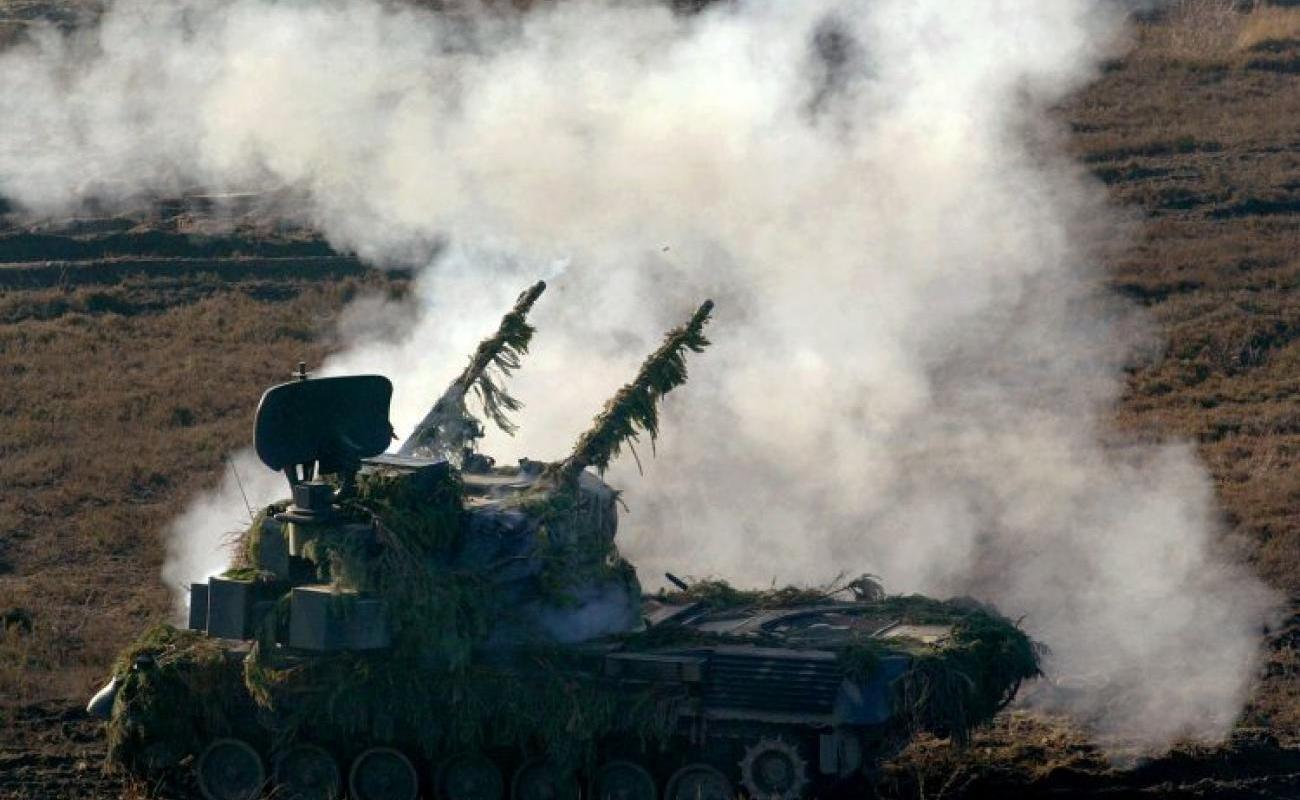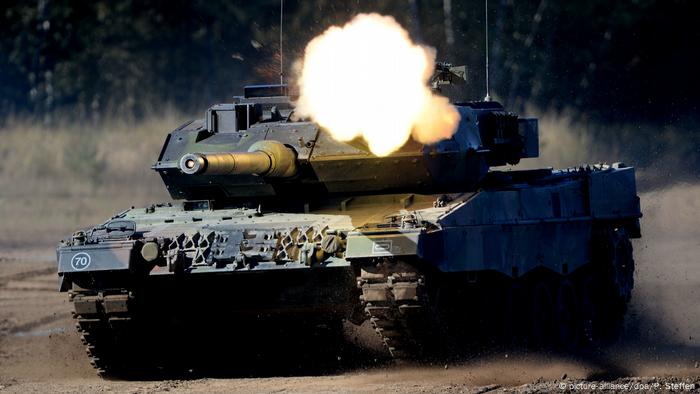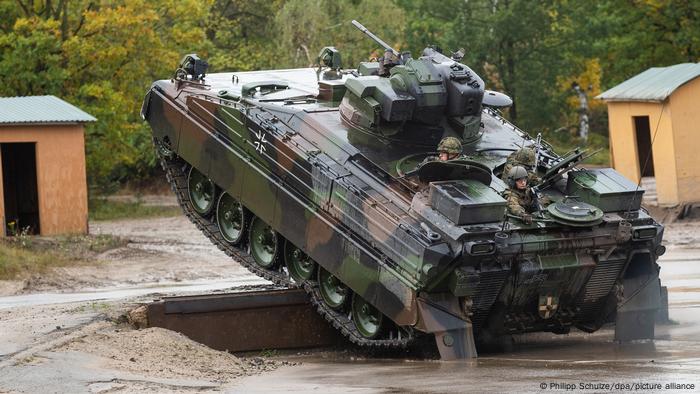What weapons Germany is sending to Ukraine
Germany is already supplying Ukraine with light weapons, while heavy systems such as tanks and artillery are to follow. DW takes a look at what Germany has already pledged — and what else Kyiv wants.

Flak tank Gepard
The Gepard (German for "cheetah") is an anti-aircraft gun, or flak tank, with twin 35-mm guns. It can be used against aircraft and helicopters at altitudes of up to 3,500 meters (11,500 feet), but also against lightly-armored ground targets such as infantry vehicles and transport tanks. This means that the Gepard can be used as both a defensive and offensive weapon. However, the Gepard would not stand a chance against a battle tank because of its relatively small-caliber guns. The Gepard has a range of about 550 kilometers (340 miles) on the road and can ford bodies of water without special additional equipment.
What makes it relevant for a mission in Ukraine is that the weapon was developed, among other things, to counter armored combat helicopters such as the Soviet-Russian Mil Mi-24 "Hind." The Gepard was introduced in 1976 and was long a cornerstone of the German military's air defenses, as well as the Dutch and Belgian armies. But in those countries, the Gepard was retired about 20 years ago, and the last one was decommissioned in Germany in 2012. Romania is the only NATO country that still uses the Gepard, and the German models must first be made operational again.
Another problem for its deployment in Ukraine may be that the anti-aircraft tank places high demands on the crew due to its complex electronics as well as radar and fire control systems. According to Johann Wadephul, defense spokesman for the conservative Christian Democrats, training takes at least six months, which is why Wadephul proposed sending the Leopard 1 tank or the Marder infantry fighting vehicle instead.
Ukraine was initially promised 50 Gepards, though there is reportedly a shortage of ammunition so far.
Howitzer 2000
This is an armored self-propelled 155-mm caliber artillery gun, whose 60 rounds can be fired at a rate of three rounds every ten seconds. Targets can be destroyed at a distance of 30 to 56 km, depending on the ammunition. The companies Krauss-Maffei Wegmann and Rheinmetall supplied the first howitzers to the Bundeswehr in 1998 and continue to produce more advanced versions.
Unlike the Leopard battle tank, the self-propelled howitzer 2000 must halt to fire, making it clearly inferior to a tank in a direct confrontation. However, it can immediately assume a new camouflage position after firing to avoid return fire.
The howitzer can travel at speeds of up to 60 km/h (37.3 m/h), has a road-range of about 420 kilometers, and can ford waters up to a depth of about 1.5 meters.
It is designed to follow motorized formations and provide them with fire support.
The howitzer was successfully used in missions in Afghanistan in 2006 and 2007 in conjunction with air support. Targets could be engaged at a range of more than 40 kilometers. According to Defense Minister Christine Lambrecht, the Bundeswehr has about 100 howitzers in its inventory, of which about 40 are operational. Chancellor Olaf Scholz has now promised Ukraine seven howitzers, but they would first have to be made operational, which is expected to take until the summer.
Marder infantry fighting vehicle
These infantry vehicles transport troops into combat, provide both fire support and cover from which soldiers can fire, making them a particularly versatile weapon system. The Marder has room for six or seven gunners, a 20-mm machine gun and Milan guided missiles against both ground and air targets.
The vehicle also has a protective ventilation system against nuclear, biological, and chemical weapons and can ford waters up to two meters deep thanks to its submersible hydraulics.
Entering service in 1971, the Marder is even older than the Cheetah and is gradually being replaced in Germany by its successor, the Puma. Nevertheless, the Marder is still in service with the Bundeswehr and in a number of other countries and has proven its usefulness both in Kosovo and Afghanistan. This was made possible by continuous upgrades overs the years.

The Leopard 2 is the showpiece of German tank production. The German government has not yet promised Ukraine either Marder or Leopard tanks to Ukraine
Leopard 2 battle tank
The Leopard 2 is the showpiece of German arms production. The battle tank has been in production since 1978 and has been improved many times since then, and the Bundeswehr does not plan to replace it until 2030.
Due to the great export success of the Krauss-Maffei Wegmann-made tank, there are many different versions, each of which has been adapted to the specific requirements of buyer countries. There are also licensed manufacturers abroad. Its predecessor, the Leopard 1, has also been sold many times and is still used by many armies around the world.
The Leopard 2's purpose is to defend against enemy tank formations. Its 120-mm cannon can be used to engage both stationary and moving targets, and can remain locked on its target even when driving over rough terrain.
The Leopard can ford waters up to four meters deep with additional equipment. Its NBC protection (against nuclear, biological, and chemical weapons) is designed to last up to 48 hours.
The 1,500-horsepower tank with a speed of more than 60 km/h is a heavyweight, though its weight of more than 60 tons is always a problem for bridges.
According to Canadian and Danish soldiers, the Leopard has proven its worth in operations in Afghanistan, primarily because of its high level of protection against attacks. It was also deployed by Turkey in northern Syria — a politically controversial operation.
The German government has not yet promised Ukraine either Marder or Leopard tanks, though Andrij Melnyk, the Ukrainian ambassador in Berlin, is calling for "the speedy export of 88 Leopard tanks, 100 Marder tanks, self-propelled howitzers, and much more."
Stinger
The Stinger is a shoulder-launched, infrared-guided surface-to-air missile launcher, originally manufactured in the US by Raytheon in 1980, though it has long been manufactured in Europe, including in Germany. After target acquisition, usually a combat aircraft or helicopter, and firing by the gunner, the missile tracks its target automatically to a range of about 4,000 meters. The warhead explodes with a slight time-delay after impact, usually on the fuel tank, increasing the effect.
Stingers have proven to be an extremely effective and easy-to-use weapon, most notably during the Soviet occupation of Afghanistan, when US-equipped Afghan fighters shot down numerous Soviet aircraft and helicopters.
In addition to the US, the Netherlands, and Latvia, Germany has supplied Ukraine with 500 Stinger anti-aircraft guns from Bundeswehr stocks since the war began.
Panzerfaust/Bunkerfaust
The Bundeswehr and other national armed forces use the standard Panzerfaust 3 for anti-tank purposes, manufactured by Dynamit Nobel in Germany since 1992. It is fired from the shoulder against stationary targets up to 400 meters away and moving targets up to 300 meters away. It can penetrate up to 300 mm of armor steel and, as a bunker buster with other ammunition, up to 240 mm of reinforced concrete.
According to the German government, Germany supplied Ukraine with several thousand such weapons early in the war.
Various small arms
By the end of April, Germany had also sent to Ukraine 100 machine guns, 100,000 hand grenades, 2,000 mines, some 5,300 explosive charges, and more than 16 million rounds of ammunition of various calibers ranging from assault rifles to heavy machine guns. This information comes from Ukrainian government circles. Unlike heavy weapons such as tanks, the German government has not disclosed which smaller weapons it is supplying.
This article was originally written in German.
While you're here: Every Tuesday, DW editors round up what is happening in German politics and society. You can sign up here for the weekly email newsletter Berlin Briefing.

